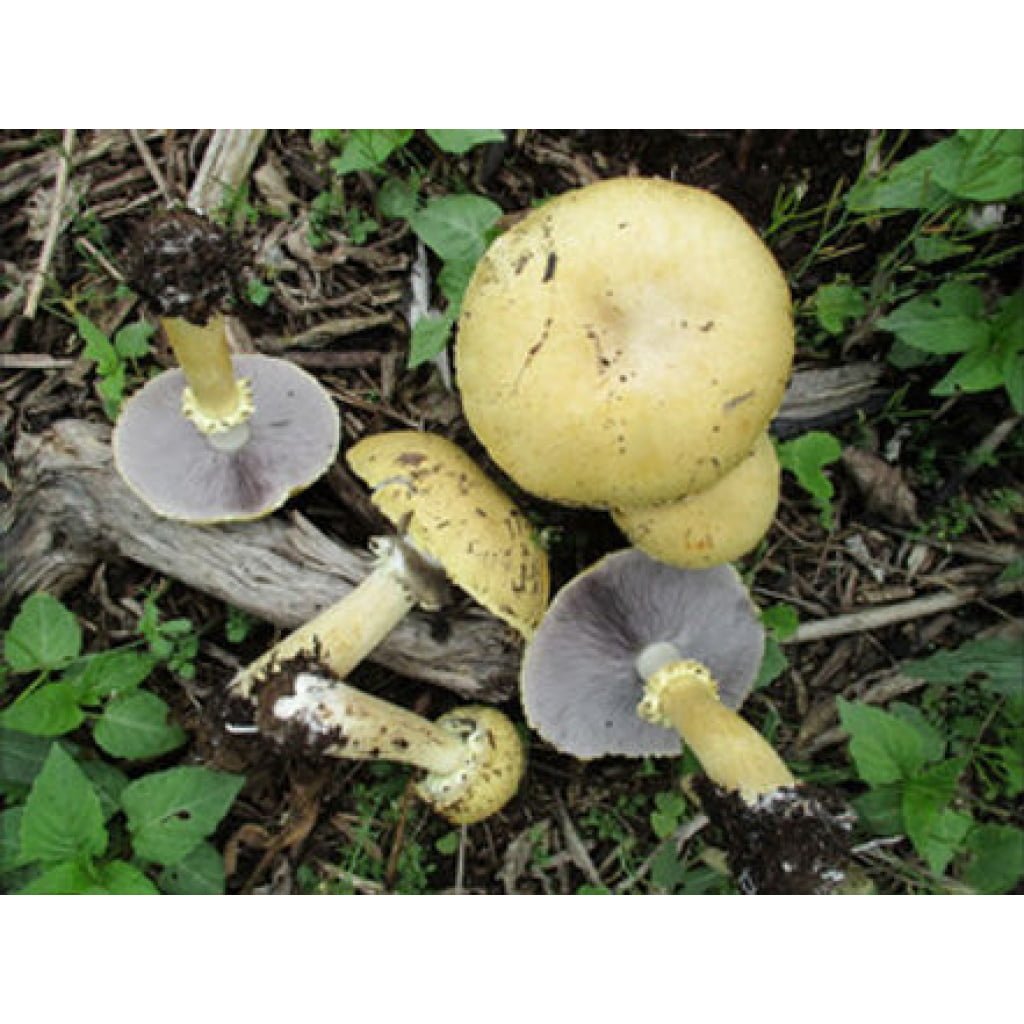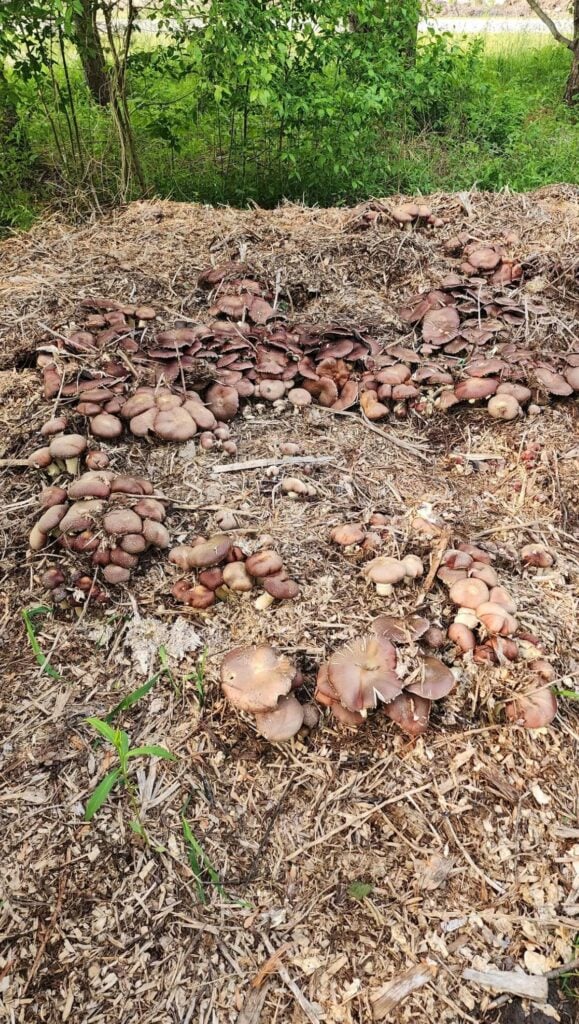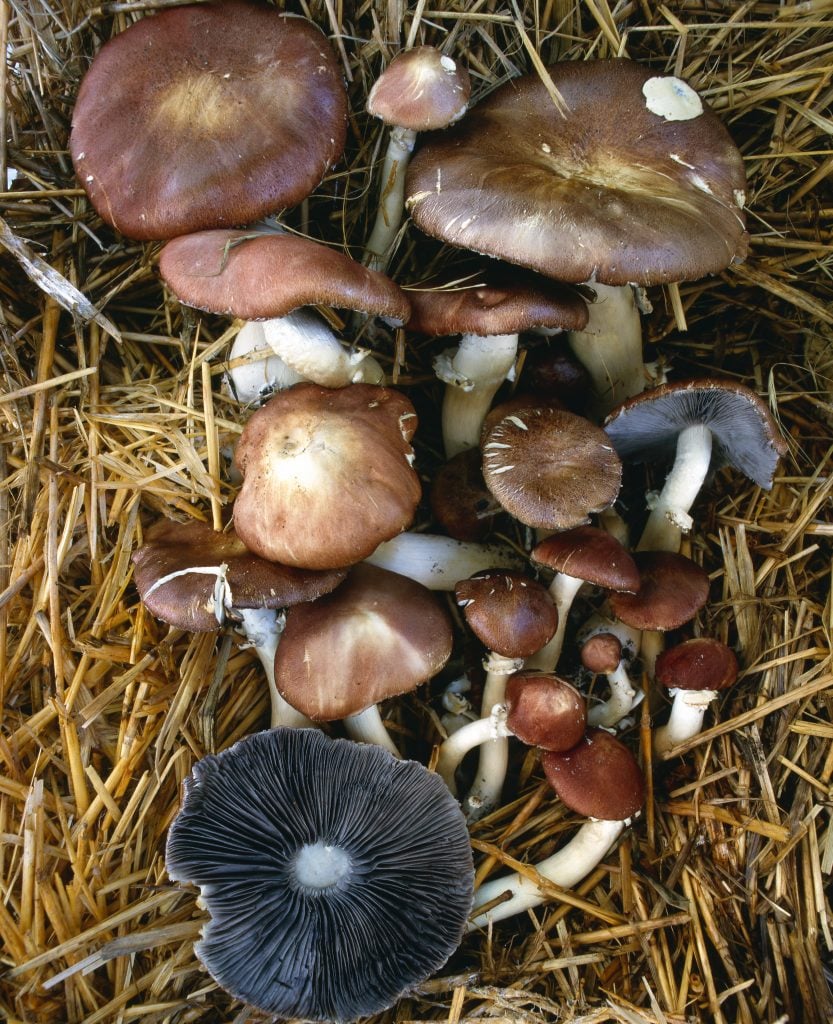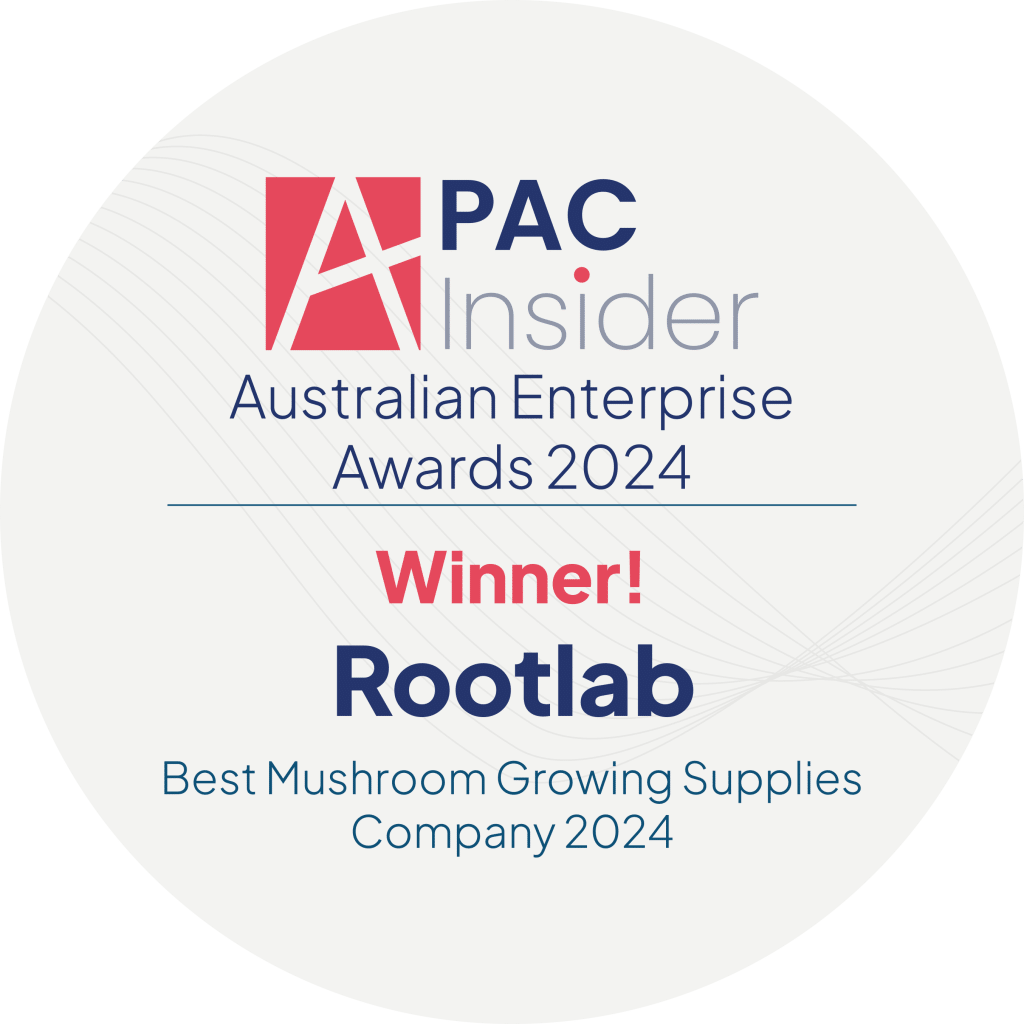Cultivation Level: Easy, Beginner, No Special Equipment Needed
Wine cap (Stropharia rugosoannulata) is an excellent mushroom for cultivation because it is easy to grow and adapts to various media. It is also called King Stropharia and Garden Giant, plus a variation called the Golden Wine Cap (Stropharia rugosoannulata var. lutea). This article explains how to cultivate these popular mushrooms, including their appearance, identification, and cultivation methods.
Appearance and Identification
Wine Cap Mushroom Red(Pictured above)
• Cap: When young, the cap is deep wine-red, burgundy, or brick to brown, fading to purplish-tan or brown as it matures. The caps range from 6 to 13 cm in diameter.
• Gills: Initially white, turning purplish grey as the mushroom matures.
• Stem: White, thick, and bulges towards the base, reaching 20 cm long.
• Spore Print: Dark purplish brown.
• Annulus: Has a ring around the stalk, a remnant of the broken veil.

Golden wine cap mushroom, Stropharia rugosoannulata var. lutea (Pictured above)
Golden Wine Cap Mushroom
• Cap: Starts bright yellow-golden, turning straw-colored or tan as it matures.
• Gills: Become increasingly crowded and attached to the stem, changing from white to purple/black in maturity.
• Spore Print: Dark purplish brown.
• Annulus: Present, with a light-coloured stalk.
Ecology of Stropharia
• Family: Strophariaceae
• Genus: Stropharia
• Species: rugosoannulata
• Common Names: King Stropharia, Garden Giant, Burgundy Mushroom, Wine Caps, Wine Red Stropharia
• Ecology: Saprobic (secondary decomposer)
Flavor Profile
• Wine Cap Flavour: Potatoes, cashews
• Golden Wine Cap Flavour: Yams, asparagus
Nutritional and Medicinal Properties
Wine cap and Golden wine cap are high in protein, fibre, potassium, magnesium and vitamins. They are an excellent source of these nutrients for vegetarians and vegans. There is some evidence that wine caps have a:
• Antitumor and Antioxidative Activity: Exopolysaccharides (EPS) prepared by S rugosoannulata have significantly high antitumor and antioxidative activity vitro.
• Antimicrobial activity: Polyphenols have antimicrobial activity, though wine caps might lack this, too. Their consumption has been promoted as a health benefit, but little evidence supports the claim.
Derivation of Golden Wine Cap
The Golden Wine Cap, Stropharia rugosoannulata var. lutea, is a variant derived from the standard wine cap4 mushroom. “var. lutea” indicates a variety within the species with distinct characteristics, such as its golden colour. This variety was likely developed through selective cultivation to emphasise its unique colouration and flavour profile.
When should we plant wine cap mycelium or establish a patch outside?
They are usually planted in spring or autumn when it’s not too cold or hot. At night, they should not get below 10°C.
Cultivation
Wine cap mushrooms are saprobic fungi that thrive on decomposing organic matter. They grow best outdoors—on shaded garden beds or under tree canopies—using fermented hardwood chips or straw inoculated with grain, sawdust, or cardboard spawn.
When ordering grain or sawdust spawn from us, you may notice that the wine cap mycelium appears thin, patchy, or even invisible. This is normal. Sawdust spawn, in particular, takes months to colonise fully and is typically sent at about 3 weeks old. Once introduced to the right outdoor environment, the mycelium grows exponentially faster than it does inside the bag.
For outdoor cultivation, we strongly recommend using sawdust spawn over grain spawn. Birds or worms are more likely to eat grains before the mycelium can establish and spread. On the other hand, Sawdust integrates more naturally into outdoor beds and offers better colonisation potential.
These mushrooms prefer complex, microbe-rich substrates, making indoor cultivation difficult. While they flourish in subtropical to cool temperate climates and can grow impressively large, they are at their best when harvested young and firm for optimal texture and flavour.
Ideal Locations
- Shaded Areas: These are optimal for moisture retention, reducing the need for frequent watering.
- Mulched Areas: Wine caps thrive in mulched garden beds, which help retain moisture.
- Under Trees: This location provides shade and benefits from natural leaf litter.
- Garden Beds: You can cultivate these with appropriate substrate preparation.
Suitable Substrates
Wine cap mushrooms can grow on various substrates, including softwood chips, hardwood chips, straw, cardboard, and leaf litter. Wood chips, especially hardwood chips, are considered the best source because they release sustained energy. Straw provides the quickest energy to wine caps.

Preparing the Substrate
Wood Chips
Soft hardwood chips like box elder, cottonwood, willow, and soft maple can be used. Hardwood chips like oak and Eucalyptus should be aged before use. Some of the reasons for aging or partially composting wood chips are provided below:
- Degrading Toxic Compounds: Freshly chipped wood can contain compounds that inhibit mushroom mycelium growth. Aging helps break down these substances, especially if they are from Eucalyptus.
- Enhancing Nutrient Accessibility: Aging renders macromolecular matter, such as lignin and cellulose, into smaller compounds that mushroom roots can absorb.
- Adjusting Moisture Content: Older chips tend to absorb and retain moisture, a quality that is very desirable for the growth of mycelium (at least 63-65 per cent is desired)
- Promotion for the growth of Mycelium; less toxicity, higher nutrients and appropriate moisture level allow chips to grow faster and fuller.
Important Considerations
The problem with using wood chips to grow mushrooms is that composted wood chips contain various microorganisms that could compete with the mushroom mycelium. However, sterilising the substrate is usually unnecessary. Instead, the goal is to favour mushroom mycelium over other organisms. Strategies include:
- Spawning Rate: The spawning rate is best kept at a level where the mushroom mycelium colonises the substrate rapidly, outcompeting other microorganisms. A higher spawning rate, around 10-20 per cent by weight, can be used.
- Pasteurization
Pasteurization Technique
Soaking composted wood chips in water aids in pasteurisation by:
- Hydrating the Substrate: The substrate should be soaked to ensure the wood chips reach the ideal moisture content for mycelium growth, which is 60-65%.
- Leaching Toxins and Excess Nutrients: Removing toxins and excess nutrients that would be attractive to competitor microbes.
- Reducing Competitor Microbes: Soaking reduces undesirable microbes, though not completely eliminating them.
Science Behind Soaking
- Creating Anaerobic Conditions: Soaking displaces air, creating an anaerobic environment that inhibits aerobic microbes.
- Promoting Anaerobic Microbes: Anaerobic microorganisms thrive, further outcompeting oxygen-dependent (aerobic) microbes.
Let them soak in water for 24 hours, and the anaerobic microbes will perish with the oxygen gone. So you are left with a medium with fewer microbes, but you have reduced your competitors, which is an advantage for growing wine cap mycelia. Once you remove the woodchips from water, they get exposed to oxygen again, and all anaerobic microbes die. You are left with a far smaller colony of microbes than you started from.
Preparing Straw
Straw can be prepared similarly by soaking it for 24 hours to achieve optimal conditions for mushroom growth.
Cultivation Methods
- In garden beds with fruits, vegetables, and herbs (Companion plants).
- In-ground under a tree
- Indoor cultivation—We do not recommend this as anything grown indoors needs to be sterile, and the wine cap needs little microbial activity to fruit; once your substrate is fully colonised, you can use a casing layer with some soil from outside.
But a wine cap requires a lot of energy and food to fruit; you may only get a few mushrooms when growing in a monotub, etc., and it’s not worth the effort. You also need to maintain proper temperature, humidity, and airflow.
Use the following information once you have chosen your location, either on the ground or raised beds.
Raised beds
Get substrate ready: Use wood chips and straw, or combine the two.
Location: Shaded areas are preferred because they reduce drying and watering needs. Avoid deep wood chip beds in raised structures to prevent the mycelium from getting suffocated.
Layer: Create layers by alternating substrate and spawn, and use straw as mulch in the top layer. Bed depth varies based on substrate and location, with wood chips requiring less depth than straw.
Maintaining and Monitoring the Bed: Regularly check moisture levels, ensuring the bed is damp but not wet. A well-placed bed may require minimal maintenance.
Re-feed: Wine waste decomposes the substrate quickly, so straw beds last about a year, while wood chip beds can last up to three years. To rejuvenate the bed, add new wood chips and possibly new spawns to encourage further growth.
Let’s talk about Layering.
One of the most essential steps in the wine cap cultivation process is substrate layering – essentially laying the substrate onto the spawn. The process starts like this:
- Layering Process: The bed is constructed by creating layers of substrate and spawn. Begin by laying down the first layer of substrate, then sprinkle the mushroom spawn broken into pieces. Continue by adding another layer of substrate. If using straw and wood chips, alternate the layers: straw, spawn, wood chips, and repeat.
- Depth Considerations: The depth of the bed varies depending on the substrate and the location. Wood chip layers should be about 2-4 inches deep, as they are less prone to drying out. Straw layers should be 5-8 inches deep, with deeper beds recommended for sunny locations to prevent drying. We do not recommend a sunny location. It does not matter if it only receives morning sun; it can still dry out the substrate. Wine caps are the most forgiving mushrooms we have seen, and they can tolerate the sun more than any other mushrooms, but that does not mean we should expose them to the sun. They will still grow better in the shade.
- Moisture Retention: The layering provides nutrients and helps retain moisture. A thicker top layer of substrate helps protect the spawn underneath from drying out, maintaining the necessary humidity for mycelium growth. We recommend using straw as the top layer.
Growing on the ground at the base of a tree:
Another way is to grow them on the ground; this method produces the most mushrooms. The mycelium network grows extensively, allowing for multiple harvests over time. Spread the wood chips and spawn in shade, covering with leaf litter, grass clippings, and straw to protect from sun and moisture loss. Keep adding woodchips every six months.
Sourcing option
Considerations for Bunnings Products in Australia
Richgro Pine Bark Mulch: Although pine bark mulch is available at Bunnings, wine cap mushrooms are more suitable. Softwoods like pine are generally less preferred due to their lower nutrient content and potential for higher acidity, which can affect mushroom growth.
Natural Hardwood Mulch: If this product contains suitable hardwood chips and is free from chemical treatments, it can be used for mushroom cultivation. However, ensuring the chips are aged or composted is essential to enhance their suitability for mushroom growth.
All the hard work is done. Now it is time to enjoy the fruit of your labour.
Mushroom Harvest
Wine Caps typically fruit 2-6 months after planting. Harvest them when they are young or wait for the cap to open and store them in the refrigerator. Twist and harvest young mushrooms when they are 5-7 cm wide. Mature mushrooms are safe to eat, but will have little to no flavour. Cut in half and braise; they are delicious with mustard or red wine sauce. Always cook wine caps before consuming them, as they can cause digestive upset when eaten raw.
FAQs
How long does it take for wine cap mushrooms to fruit?
Wine cap mushrooms will fruit two to six months after inoculation. The timing is dependent on environmental factors and substrate inoculation material. Straw will produce a quicker crop than hardwood chips, but it won’t last long. Hardwood chips will take longer to fruit, but will then produce mushrooms for a long period of time.
How do Golden Wine Caps differ in growth from regular Wine Caps?
Both Golden wine caps and regular wine caps grow under similar conditions. They only differ in taste and the color of the caps.
Are Golden Wine Caps safe to consume?
Yes, Golden Wine Caps are safe for consumption and have culinary applications. However, proper identification and preparation are essential, as with all mushrooms.
Can wine cap mushrooms be grown indoors?
These mushrooms need soil microbes to initiate fruiting and so indoor fruiting will lead to only 1-2 mushroom bodies or no fruits at all. We advise against growing wine cap indoors.
What are the benefits of using wood chips over straw?
Wood chips provide a more sustained nutrition and energy, and the mushrooms fruiting period will be prolonged. While straw may cause faster fruiting but will need to be replenished more frequently.
What do wine cap mushrooms taste like?
Wine cap mushrooms have a firm, robust texture and a mild flavor like that of asparagus, yams, potatoes, or cashews.
Are wine cap mushrooms psychedelic?
No, wine cap mushrooms or Golden wine wap mushrooms are not psychedelic and are safe for culinary use.
Are wine cap mushrooms poisonous to dogs?
Although the wine cap mushroom is not toxic, we do recommend calling your vet about feeding pets any wild mushrooms to be safe. As a general rule, no one should eat mushrooms raw – pets, people or otherwise. Pets should not be fed whole mushrooms, but supplements are fine as long as they are made for pets.
Where do wine cap mushrooms grow?
Wine cap mushrooms typically grow in garden beds, shaded areas, and locations with ample organic matter, such as under trees or in mulched areas. They prefer a combination of sawdust and woodchips.
What is the price per kg of wine cap mushrooms?
Wine cap mushrooms are rarely sold in shops as they are not commercially cultivated indoors. They may be available at farmers' markets, with prices potentially exceeding AUD 65/kg, depending on location.
How to preserve wine cap mushrooms?
Wine cap mushrooms can be preserved through drying, freeze-drying, or pickling.
How to take wine cap mushroom spores?
To collect spores, place a mature cap gill-side down on a piece of foil and cover it with a bowl. After 12-5 hours, the spores will have dropped onto the foil. Ensure the spores are dark purplish-brown for cultivation. You can watch our video on how to take spore print
Why is a spore different from sawdust spawn you buy from Rootlab?
Spores are the reproductive units of the mushroom, used to start new colonies, while sawdust spawn is already colonized with mycelium, ready for faster growth. Sawdust spawn consists of a single organism made from compatible spores that have been tested for consistent fruiting.
Where can I find wine cap mushroom spawn in Australia?
Wine cap mushroom spawn can be sourced from Rootlab, available in Liquid culture, grain spawn, and sawdust spawn forms. Sawdust spawn is recommended for outdoor cultivation to prevent birds from eating the spawn.
Where can I purchase wine cap mushroom spawn?
Spawn can be purchased from our wine cap sawdust spawn listing. Please ensure you have woodchips or straw before proceeding to buy the spawn.
How can I buy red wine cap mushroom spawn?
You can make your own spawn using a liquid culture or buy the sawdust spawn directly from our Spawn listing.
What is included in a wine cap mushroom grow kit?
Wine cap mushrooms do not typically come in grow kits. Use sawdust spawn from Rootlab to cultivate your own wine caps. This article includes a tutorial that walks you through the process.
What is the difference between a grow kit and a mushroom kit?
Both provide comprehensive solutions for beginners, they are typically the same thing and are sometimes also called spray and grow kits.
Why is wine cap mushroom mycelium important for mushroom growth?
Mycelium is crucial because it spreads through the substrate to produce mushrooms. The mycelium that Rootlab produces is reliable and has a reputation for prolific fruiting.
Where can I find wine cap mushroom spores for sale?
Wine cap spores can be bought from our Liquid culture listing here.
How much wine cap can I harvest?
Harvesting typically occurs twice a year, in spring and autumn. Wine caps grown in the ground generally produce more than those in raised beds.
Can you consume this mushroom daily?
While it is generally safe, some individuals may experience indigestion or nausea if consumed daily, especially when combined with alcohol. However, this reaction is rare.
Can I continue growing wine cap mushrooms forever without buying more spawn?
Yes, by creating cardboard spawn. Place harvested stem butts from your wine caps in damp cardboard and wait for colonization, which takes about 2 weeks. Use this cardboard spawn in raised beds, layering it between the substrate to propagate more mushrooms.
Disclaimer
Rootlab cannot ensure the safety of consuming mushrooms that may look like Wine cap or any wild-harvested mushrooms, and we are not liable for any adverse effects. It is crucial not to eat mushrooms raw or give them to pets. If you experience any symptoms of discomfort, seek immediate advice from a poison control centre, veterinarian, or medical professional. Before consuming any mushrooms, be meticulous: take detailed photos of the stem, stem base, gills, cap, and surrounding environment, and record the time and location of fruiting. If needed, bring the actual mushroom to a healthcare provider for proper identification. Online communities, like specific Facebook groups, can help with mushroom identification. Please be aware that Rootlab does not offer identification services due to insurance constraints. We strongly recommend joining the “Poison Help: Emergency Identification of Mushrooms and Plants” Facebook group now, familiarize yourself with its rules and follow the steps of taking and sharing the necessary photos and information. In case of an emergency, go to the hospital or vet immediately and do not wait for a response from the group. If the hospital contacts poison control, providing the name or species identified by the Facebook group can expedite the diagnosis and treatment.





